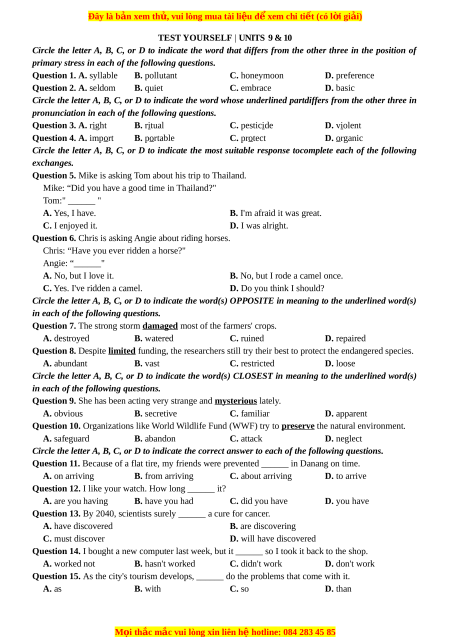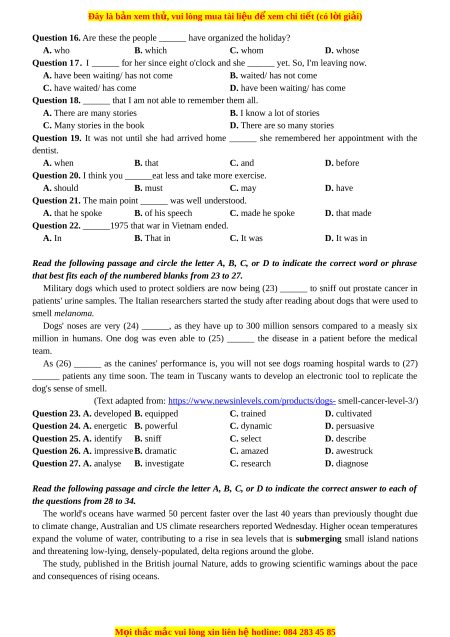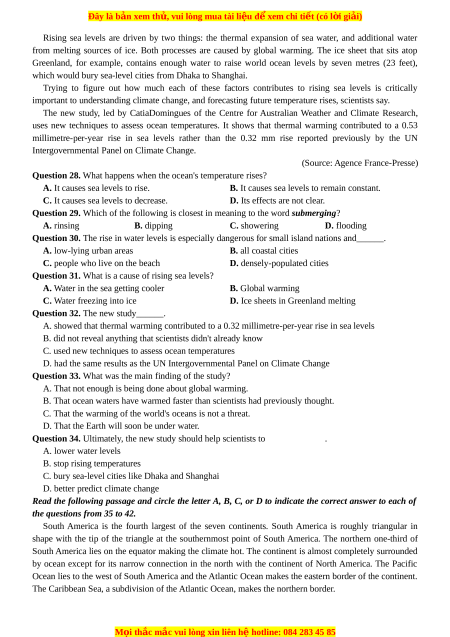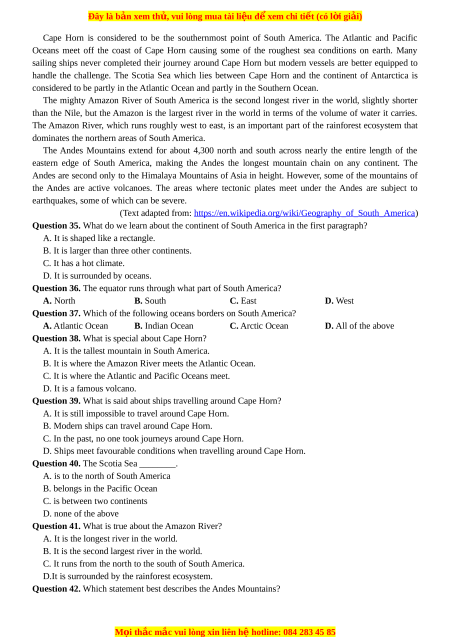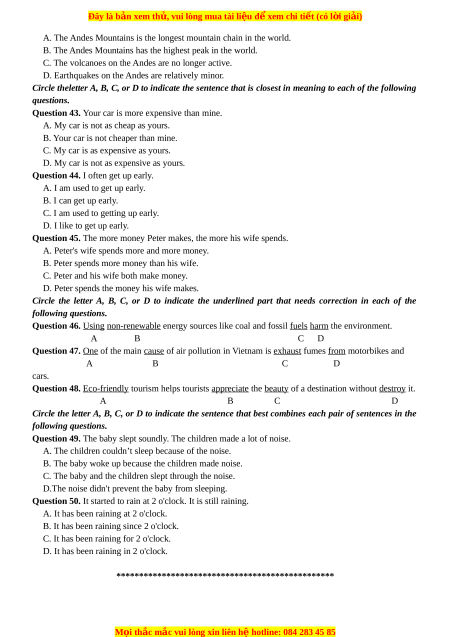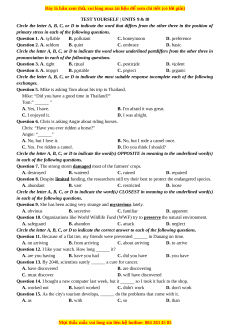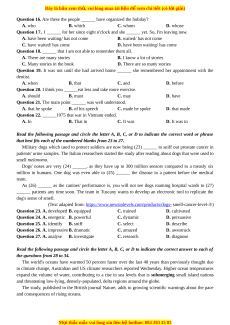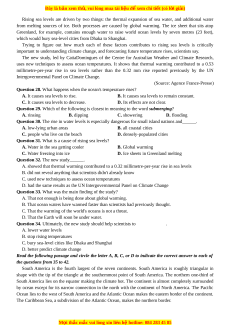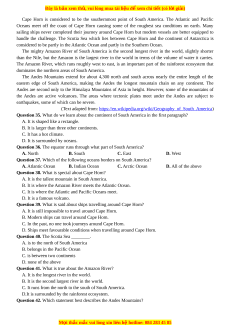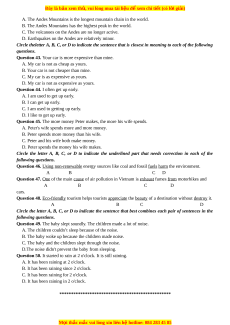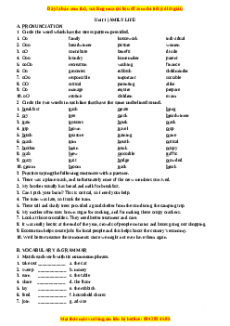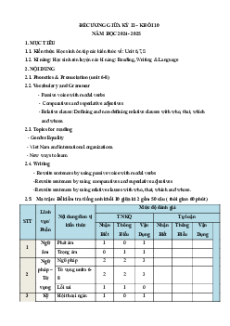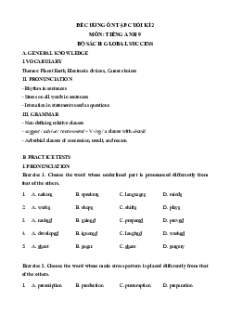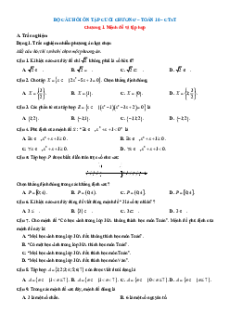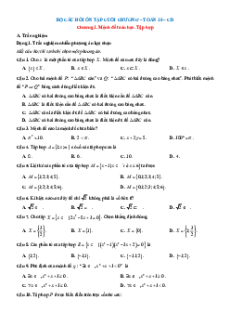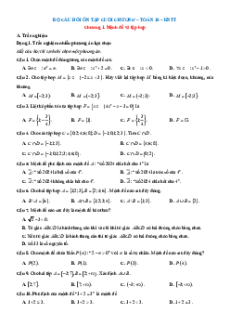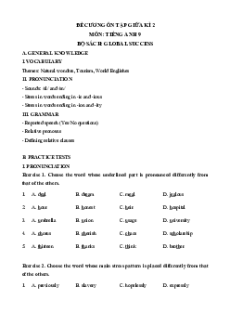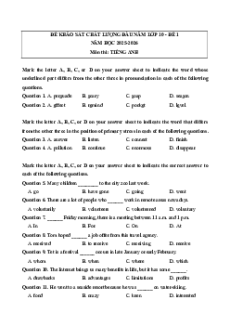ệ đ xe ể m chi ti t ế (có l i ờ gi i ả )
TEST YOURSELF | UNITS 9 & 10
Circle the letter A, B, C, or D to indicate the word that differs from the other three in the position of
primary stress in each of the following questions.
Question 1. A. syllable B. pollutant C. honeymoon D. preference
Question 2. A. seldom B. quiet C. embrace D. basic
Circle the letter A, B, C, or D to indicate the word whose underlined partdiffers from the other three in
pronunciation in each of the following questions.
Question 3. A. right B. ritual C. pesticide D. violent
Question 4. A. import B. portable C. protect D. organic
Circle the letter A, B, C, or D to indicate the most suitable response tocomplete each of the following exchanges.
Question 5. Mike is asking Tom about his trip to Thailand.
Mike: “Did you have a good time in Thailand?" Tom:" ______ " A. Yes, I have.
B. I'm afraid it was great. C. I enjoyed it. D. I was alright.
Question 6. Chris is asking Angie about riding horses.
Chris: “Have you ever ridden a horse?" Angie: “______" A. No, but I love it.
B. No, but I rode a camel once.
C. Yes. I've ridden a camel.
D. Do you think I should?
Circle the letter A, B, C, or D to indicate the word(s) OPPOSITE in meaning to the underlined word(s)
in each of the following questions.
Question 7. The strong storm damaged most of the farmers' crops. A. destroyed B. watered C. ruined D. repaired
Question 8. Despite limited funding, the researchers still try their best to protect the endangered species. A. abundant B. vast C. restricted D. loose
Circle the letter A, B, C, or D to indicate the word(s) CLOSEST in meaning to the underlined word(s)
in each of the following questions.
Question 9. She has been acting very strange and mysterious lately. A. obvious B. secretive C. familiar D. apparent
Question 10. Organizations like World Wildlife Fund (WWF) try to preserve the natural environment. A. safeguard B. abandon C. attack D. neglect
Circle the letter A, B, C, or D to indicate the correct answer to each of the following questions.
Question 11. Because of a flat tire, my friends were prevented ______ in Danang on time. A. on arriving B. from arriving C. about arriving D. to arrive
Question 12. I like your watch. How long ______ it? A. are you having B. have you had C. did you have D. you have
Question 13. By 2040, scientists surely ______ a cure for cancer. A. have discovered B. are discovering C. must discover D. will have discovered
Question 14. I bought a new computer last week, but it ______ so I took it back to the shop. A. worked not B. hasn't worked C. didn't work D. don't work
Question 15. As the city's tourism develops, ______ do the problems that come with it. A. as B. with C. so D. than M i
ọ thắc mắc vui lòng xin liên hệ hotline: 084 283 45 85
ệ đ xe ể m chi ti t ế (có l i ờ gi i ả )
Question 16. Are these the people ______ have organized the holiday? A. who B. which C. whom D. whose
Question 17. I ______ for her since eight o'clock and she ______ yet. So, I'm leaving now.
A. have been waiting/ has not come B. waited/ has not come
C. have waited/ has come
D. have been waiting/ has come
Question 18. ______ that I am not able to remember them all.
A. There are many stories
B. I know a lot of stories
C. Many stories in the book
D. There are so many stories
Question 19. It was not until she had arrived home ______ she remembered her appointment with the dentist. A. when B. that C. and D. before
Question 20. I think you ______eat less and take more exercise. A. should B. must C. may D. have
Question 21. The main point ______ was well understood. A. that he spoke B. of his speech C. made he spoke D. that made
Question 22. ______1975 that war in Vietnam ended. A. In B. That in C. It was D. It was in
Read the following passage and circle the letter A, B, C, or D to indicate the correct word or phrase
that best fits each of the numbered blanks from 23 to 27.
Military dogs which used to protect soldiers are now being (23) ______ to sniff out prostate cancer in
patients' urine samples. The Italian researchers started the study after reading about dogs that were used to smell melanoma.
Dogs' noses are very (24) ______, as they have up to 300 million sensors compared to a measly six
million in humans. One dog was even able to (25) ______ the disease in a patient before the medical team.
As (26) ______ as the canines' performance is, you will not see dogs roaming hospital wards to (27)
______ patients any time soon. The team in Tuscany wants to develop an electronic tool to replicate the dog's sense of smell.
(Text adapted from: https://www.newsinlevels.com/products/dogs- smell-cancer-level-3/)
Question 23. A. developed B. equipped C. trained D. cultivated
Question 24. A. energetic B. powerful C. dynamic D. persuasive
Question 25. A. identify B. sniff C. select D. describe
Question 26. A. impressive B. dramatic C. amazed D. awestruck
Question 27. A. analyse B. investigate C. research D. diagnose
Read the following passage and circle the letter A, B, C, or D to indicate the correct answer to each of
the questions from 28 to 34.
The world's oceans have warmed 50 percent faster over the last 40 years than previously thought due
to climate change, Australian and US climate researchers reported Wednesday. Higher ocean temperatures
expand the volume of water, contributing to a rise in sea levels that is submerging small island nations
and threatening low-lying, densely-populated, delta regions around the globe.
The study, published in the British journal Nature, adds to growing scientific warnings about the pace
and consequences of rising oceans. M i
ọ thắc mắc vui lòng xin liên hệ hotline: 084 283 45 85
ệ đ xe ể m chi ti t ế (có l i ờ gi i ả )
Rising sea levels are driven by two things: the thermal expansion of sea water, and additional water
from melting sources of ice. Both processes are caused by global warming. The ice sheet that sits atop
Greenland, for example, contains enough water to raise world ocean levels by seven metres (23 feet),
which would bury sea-level cities from Dhaka to Shanghai.
Trying to figure out how much each of these factors contributes to rising sea levels is critically
important to understanding climate change, and forecasting future temperature rises, scientists say.
The new study, led by CatiaDomingues of the Centre for Australian Weather and Climate Research,
uses new techniques to assess ocean temperatures. It shows that thermal warming contributed to a 0.53
millimetre-per-year rise in sea levels rather than the 0.32 mm rise reported previously by the UN
Intergovernmental Panel on Climate Change. (Source: Agence France-Presse)
Question 28. What happens when the ocean's temperature rises?
A. It causes sea levels to rise.
B. It causes sea levels to remain constant.
C. It causes sea levels to decrease.
D. Its effects are not clear.
Question 29. Which of the following is closest in meaning to the word submerging? A. rinsing B. dipping C. showering D. flooding
Question 30. The rise in water levels is especially dangerous for small island nations and______.
A. low-lying urban areas B. all coastal cities
C. people who live on the beach
D. densely-populated cities
Question 31. What is a cause of rising sea levels?
A. Water in the sea getting cooler B. Global warming
C. Water freezing into ice
D. Ice sheets in Greenland melting
Question 32. The new study______.
A. showed that thermal warming contributed to a 0.32 millimetre-per-year rise in sea levels
B. did not reveal anything that scientists didn't already know
C. used new techniques to assess ocean temperatures
D. had the same results as the UN Intergovernmental Panel on Climate Change
Question 33. What was the main finding of the study?
A. That not enough is being done about global warming.
B. That ocean waters have warmed faster than scientists had previously thought.
C. That the warming of the world's oceans is not a threat.
D. That the Earth will soon be under water.
Question 34. Ultimately, the new study should help scientists to . A. lower water levels B. stop rising temperatures
C. bury sea-level cities like Dhaka and Shanghai
D. better predict climate change
Read the following passage and circle the letter A, B, C, or D to indicate the correct answer to each of
the questions from 35 to 42.
South America is the fourth largest of the seven continents. South America is roughly triangular in
shape with the tip of the triangle at the southernmost point of South America. The northern one-third of
South America lies on the equator making the climate hot. The continent is almost completely surrounded
by ocean except for its narrow connection in the north with the continent of North America. The Pacific
Ocean lies to the west of South America and the Atlantic Ocean makes the eastern border of the continent.
The Caribbean Sea, a subdivision of the Atlantic Ocean, makes the northern border. M i
ọ thắc mắc vui lòng xin liên hệ hotline: 084 283 45 85
ệ đ xe ể m chi ti t ế (có l i ờ gi i ả )
Cape Horn is considered to be the southernmost point of South America. The Atlantic and Pacific
Oceans meet off the coast of Cape Horn causing some of the roughest sea conditions on earth. Many
sailing ships never completed their journey around Cape Horn but modern vessels are better equipped to
handle the challenge. The Scotia Sea which lies between Cape Horn and the continent of Antarctica is
considered to be partly in the Atlantic Ocean and partly in the Southern Ocean.
The mighty Amazon River of South America is the second longest river in the world, slightly shorter
than the Nile, but the Amazon is the largest river in the world in terms of the volume of water it carries.
The Amazon River, which runs roughly west to east, is an important part of the rainforest ecosystem that
dominates the northern areas of South America.
The Andes Mountains extend for about 4,300 north and south across nearly the entire length of the
eastern edge of South America, making the Andes the longest mountain chain on any continent. The
Andes are second only to the Himalaya Mountains of Asia in height. However, some of the mountains of
the Andes are active volcanoes. The areas where tectonic plates meet under the Andes are subject to
earthquakes, some of which can be severe.
(Text adapted from: https://en.wikipedia.org/wiki/Geography_of_South_America)
Question 35. What do we learn about the continent of South America in the first paragraph?
A. It is shaped like a rectangle.
B. It is larger than three other continents. C. It has a hot climate. D. It is surrounded by oceans.
Question 36. The equator runs through what part of South America? A. North B. South C. East D. West
Question 37. Which of the following oceans borders on South America? A. Atlantic Ocean B. Indian Ocean C. Arctic Ocean D. All of the above
Question 38. What is special about Cape Horn?
A. It is the tallest mountain in South America.
B. It is where the Amazon River meets the Atlantic Ocean.
C. It is where the Atlantic and Pacific Oceans meet. D. It is a famous volcano.
Question 39. What is said about ships travelling around Cape Horn?
A. It is still impossible to travel around Cape Horn.
B. Modern ships can travel around Cape Horn.
C. In the past, no one took journeys around Cape Horn.
D. Ships meet favourable conditions when travelling around Cape Horn.
Question 40. The Scotia Sea ________.
A. is to the north of South America
B. belongs in the Pacific Ocean C. is between two continents D. none of the above
Question 41. What is true about the Amazon River?
A. It is the longest river in the world.
B. It is the second largest river in the world.
C. It runs from the north to the south of South America.
D.It is surrounded by the rainforest ecosystem.
Question 42. Which statement best describes the Andes Mountains? M i
ọ thắc mắc vui lòng xin liên hệ hotline: 084 283 45 85
Bài tập Test yourself Unit 9,10 Tiếng Anh 10 cơ bản - nâng cao
403
202 lượt tải
MUA NGAY ĐỂ XEM TOÀN BỘ TÀI LIỆU
CÁCH MUA:
- B1: Gửi phí vào TK:
1133836868- CT TNHH DAU TU VA DV GD VIETJACK - Ngân hàng MB (QR) - B2: Nhắn tin tới Zalo VietJack Official ( nhấn vào đây ) để xác nhận thanh toán và tải tài liệu - giáo án
Liên hệ ngay Hotline hỗ trợ: 084 283 45 85
Tài liệu được cập nhật liên tục trong gói này từ nay đến hết tháng 6/2023. Chúng tôi đảm bảo đủ số lượng đề đã cam kết hoặc có thể nhiều hơn, tất cả có BẢN WORD, LỜI GIẢI CHI TIẾT và tải về dễ dàng.
Để tải tài liệu gốc về máy bạn click vào nút Tải Xuống ở trên!
Thuộc bộ (mua theo bộ để tiết kiệm hơn):
- Tailieugiaovien.com.vn giới thiệu Bộ bài tập trắc nghiệm cơ bản - nâng cao Tiếng Anh lớp 10 biên soạn bởi GV Nguyễn Ngọc Bảo Châu mới nhất nhằm giúp Giáo viên có thêm tài liệu tham khảo bài tập Tiếng Anh lớp 10.
- File word có lời giải chi tiết 100%.
- Mua trọn bộ sẽ tiết kiệm hơn tải lẻ 50%.
Đánh giá
4.6 / 5(403 )5
4
3
2
1
Trọng Bình
Tài liệu hay
Giúp ích cho tôi rất nhiều
Duy Trần
Tài liệu chuẩn
Rất thích tài liệu bên VJ soạn (bám sát chương trình dạy)
TÀI LIỆU BỘ BÁN CHẠY MÔN Tiếng Anh
Xem thêmTÀI LIỆU BỘ BÁN CHẠY Lớp 10
Xem thêmTài liệu bộ mới nhất

Đây là b nả xem thử, vui lòng mua tài li u đ xem chi ti t (có l i gi i)ệ ể ế ờ ả
TEST YOURSELF | UNITS 9 & 10
Circle the letter A, B, C, or D to indicate the word that differs from the other three in the position of
primary stress in each of the following questions.
Question 1. A. syllable B. pollutant C. honeymoon D. preference
Question 2. A. seldom B. quiet C. embrace D. basic
Circle the letter A, B, C, or D to indicate the word whose underlined partdiffers from the other three in
pronunciation in each of the following questions.
Question 3. A. right B. ritual C. pesticide D. violent
Question 4. A. import B. portable C. protect D. organic
Circle the letter A, B, C, or D to indicate the most suitable response tocomplete each of the following
exchanges.
Question 5. Mike is asking Tom about his trip to Thailand.
Mike: “Did you have a good time in Thailand?"
Tom:" ______ "
A. Yes, I have. B. I'm afraid it was great.
C. I enjoyed it. D. I was alright.
Question 6. Chris is asking Angie about riding horses.
Chris: “Have you ever ridden a horse?"
Angie: “______"
A. No, but I love it. B. No, but I rode a camel once.
C. Yes. I've ridden a camel. D. Do you think I should?
Circle the letter A, B, C, or D to indicate the word(s) OPPOSITE in meaning to the underlined word(s)
in each of the following questions.
Question 7. The strong storm damaged most of the farmers' crops.
A. destroyed B. watered C. ruined D. repaired
Question 8. Despite limited funding, the researchers still try their best to protect the endangered species.
A. abundant B. vast C. restricted D. loose
Circle the letter A, B, C, or D to indicate the word(s) CLOSEST in meaning to the underlined word(s)
in each of the following questions.
Question 9. She has been acting very strange and mysterious lately.
A. obvious B. secretive C. familiar D. apparent
Question 10. Organizations like World Wildlife Fund (WWF) try to preserve the natural environment.
A. safeguard B. abandon C. attack D. neglect
Circle the letter A, B, C, or D to indicate the correct answer to each of the following questions.
Question 11. Because of a flat tire, my friends were prevented ______ in Danang on time.
A. on arriving B. from arriving C. about arriving D. to arrive
Question 12. I like your watch. How long ______ it?
A. are you having B. have you had C. did you have D. you have
Question 13. By 2040, scientists surely ______ a cure for cancer.
A. have discovered B. are discovering
C. must discover D. will have discovered
Question 14. I bought a new computer last week, but it ______ so I took it back to the shop.
A. worked not B. hasn't worked C. didn't work D. don't work
Question 15. As the city's tourism develops, ______ do the problems that come with it.
A. as B. with C. so D. than
M iọ th c m c vui lòng xin liên hắ ắ ệ hotline: 084 283 45 85

Đây là b nả xem thử, vui lòng mua tài li u đ xem chi ti t (có l i gi i)ệ ể ế ờ ả
Question 16. Are these the people ______ have organized the holiday?
A. who B. which C. whom D. whose
Question 17. I ______ for her since eight o'clock and she ______ yet. So, I'm leaving now.
A. have been waiting/ has not come B. waited/ has not come
C. have waited/ has come D. have been waiting/ has come
Question 18. ______ that I am not able to remember them all.
A. There are many stories B. I know a lot of stories
C. Many stories in the book D. There are so many stories
Question 19. It was not until she had arrived home ______ she remembered her appointment with the
dentist.
A. when B. that C. and D. before
Question 20. I think you ______eat less and take more exercise.
A. should B. must C. may D. have
Question 21. The main point ______ was well understood.
A. that he spoke B. of his speech C. made he spoke D. that made
Question 22. ______1975 that war in Vietnam ended.
A. In B. That in C. It was D. It was in
Read the following passage and circle the letter A, B, C, or D to indicate the correct word or phrase
that best fits each of the numbered blanks from 23 to 27.
Military dogs which used to protect soldiers are now being (23) ______ to sniff out prostate cancer in
patients' urine samples. The Italian researchers started the study after reading about dogs that were used to
smell melanoma.
Dogs' noses are very (24) ______, as they have up to 300 million sensors compared to a measly six
million in humans. One dog was even able to (25) ______ the disease in a patient before the medical
team.
As (26) ______ as the canines' performance is, you will not see dogs roaming hospital wards to (27)
______ patients any time soon. The team in Tuscany wants to develop an electronic tool to replicate the
dog's sense of smell.
(Text adapted from: https://www.newsinlevels.com/products/dogs- smell-cancer-level-3/)
Question 23. A. developed B. equipped C. trained D. cultivated
Question 24. A. energetic B. powerful C. dynamic D. persuasive
Question 25. A. identify B. sniff C. select D. describe
Question 26. A. impressiveB. dramatic C. amazed D. awestruck
Question 27. A. analyse B. investigate C. research D. diagnose
Read the following passage and circle the letter A, B, C, or D to indicate the correct answer to each of
the questions from 28 to 34.
The world's oceans have warmed 50 percent faster over the last 40 years than previously thought due
to climate change, Australian and US climate researchers reported Wednesday. Higher ocean temperatures
expand the volume of water, contributing to a rise in sea levels that is submerging small island nations
and threatening low-lying, densely-populated, delta regions around the globe.
The study, published in the British journal Nature, adds to growing scientific warnings about the pace
and consequences of rising oceans.
M iọ th c m c vui lòng xin liên hắ ắ ệ hotline: 084 283 45 85

Đây là b nả xem thử, vui lòng mua tài li u đ xem chi ti t (có l i gi i)ệ ể ế ờ ả
Rising sea levels are driven by two things: the thermal expansion of sea water, and additional water
from melting sources of ice. Both processes are caused by global warming. The ice sheet that sits atop
Greenland, for example, contains enough water to raise world ocean levels by seven metres (23 feet),
which would bury sea-level cities from Dhaka to Shanghai.
Trying to figure out how much each of these factors contributes to rising sea levels is critically
important to understanding climate change, and forecasting future temperature rises, scientists say.
The new study, led by CatiaDomingues of the Centre for Australian Weather and Climate Research,
uses new techniques to assess ocean temperatures. It shows that thermal warming contributed to a 0.53
millimetre-per-year rise in sea levels rather than the 0.32 mm rise reported previously by the UN
Intergovernmental Panel on Climate Change.
(Source: Agence France-Presse)
Question 28. What happens when the ocean's temperature rises?
A. It causes sea levels to rise. B. It causes sea levels to remain constant.
C. It causes sea levels to decrease. D. Its effects are not clear.
Question 29. Which of the following is closest in meaning to the word submerging?
A. rinsing B. dipping C. showering D. flooding
Question 30. The rise in water levels is especially dangerous for small island nations and______.
A. low-lying urban areas B. all coastal cities
C. people who live on the beach D. densely-populated cities
Question 31. What is a cause of rising sea levels?
A. Water in the sea getting cooler B. Global warming
C. Water freezing into ice D. Ice sheets in Greenland melting
Question 32. The new study______.
A. showed that thermal warming contributed to a 0.32 millimetre-per-year rise in sea levels
B. did not reveal anything that scientists didn't already know
C. used new techniques to assess ocean temperatures
D. had the same results as the UN Intergovernmental Panel on Climate Change
Question 33. What was the main finding of the study?
A. That not enough is being done about global warming.
B. That ocean waters have warmed faster than scientists had previously thought.
C. That the warming of the world's oceans is not a threat.
D. That the Earth will soon be under water.
Question 34. Ultimately, the new study should help scientists to .
A. lower water levels
B. stop rising temperatures
C. bury sea-level cities like Dhaka and Shanghai
D. better predict climate change
Read the following passage and circle the letter A, B, C, or D to indicate the correct answer to each of
the questions from 35 to 42.
South America is the fourth largest of the seven continents. South America is roughly triangular in
shape with the tip of the triangle at the southernmost point of South America. The northern one-third of
South America lies on the equator making the climate hot. The continent is almost completely surrounded
by ocean except for its narrow connection in the north with the continent of North America. The Pacific
Ocean lies to the west of South America and the Atlantic Ocean makes the eastern border of the continent.
The Caribbean Sea, a subdivision of the Atlantic Ocean, makes the northern border.
M iọ th c m c vui lòng xin liên hắ ắ ệ hotline: 084 283 45 85

Đây là b nả xem thử, vui lòng mua tài li u đ xem chi ti t (có l i gi i)ệ ể ế ờ ả
Cape Horn is considered to be the southernmost point of South America. The Atlantic and Pacific
Oceans meet off the coast of Cape Horn causing some of the roughest sea conditions on earth. Many
sailing ships never completed their journey around Cape Horn but modern vessels are better equipped to
handle the challenge. The Scotia Sea which lies between Cape Horn and the continent of Antarctica is
considered to be partly in the Atlantic Ocean and partly in the Southern Ocean.
The mighty Amazon River of South America is the second longest river in the world, slightly shorter
than the Nile, but the Amazon is the largest river in the world in terms of the volume of water it carries.
The Amazon River, which runs roughly west to east, is an important part of the rainforest ecosystem that
dominates the northern areas of South America.
The Andes Mountains extend for about 4,300 north and south across nearly the entire length of the
eastern edge of South America, making the Andes the longest mountain chain on any continent. The
Andes are second only to the Himalaya Mountains of Asia in height. However, some of the mountains of
the Andes are active volcanoes. The areas where tectonic plates meet under the Andes are subject to
earthquakes, some of which can be severe.
(Text adapted from: https://en.wikipedia.org/wiki/Geography_of_South_America)
Question 35. What do we learn about the continent of South America in the first paragraph?
A. It is shaped like a rectangle.
B. It is larger than three other continents.
C. It has a hot climate.
D. It is surrounded by oceans.
Question 36. The equator runs through what part of South America?
A. North B. South C. East D. West
Question 37. Which of the following oceans borders on South America?
A. Atlantic Ocean B. Indian Ocean C. Arctic Ocean D. All of the above
Question 38. What is special about Cape Horn?
A. It is the tallest mountain in South America.
B. It is where the Amazon River meets the Atlantic Ocean.
C. It is where the Atlantic and Pacific Oceans meet.
D. It is a famous volcano.
Question 39. What is said about ships travelling around Cape Horn?
A. It is still impossible to travel around Cape Horn.
B. Modern ships can travel around Cape Horn.
C. In the past, no one took journeys around Cape Horn.
D. Ships meet favourable conditions when travelling around Cape Horn.
Question 40. The Scotia Sea ________.
A. is to the north of South America
B. belongs in the Pacific Ocean
C. is between two continents
D. none of the above
Question 41. What is true about the Amazon River?
A. It is the longest river in the world.
B. It is the second largest river in the world.
C. It runs from the north to the south of South America.
D.It is surrounded by the rainforest ecosystem.
Question 42. Which statement best describes the Andes Mountains?
M iọ th c m c vui lòng xin liên hắ ắ ệ hotline: 084 283 45 85

Đây là b nả xem thử, vui lòng mua tài li u đ xem chi ti t (có l i gi i)ệ ể ế ờ ả
A. The Andes Mountains is the longest mountain chain in the world.
B. The Andes Mountains has the highest peak in the world.
C. The volcanoes on the Andes are no longer active.
D. Earthquakes on the Andes are relatively minor.
Circle theletter A, B, C, or D to indicate the sentence that is closest in meaning to each of the following
questions.
Question 43. Your car is more expensive than mine.
A. My car is not as cheap as yours.
B. Your car is not cheaper than mine.
C. My car is as expensive as yours.
D. My car is not as expensive as yours.
Question 44. I often get up early.
A. I am used to get up early.
B. I can get up early.
C. I am used to getting up early.
D. I like to get up early.
Question 45. The more money Peter makes, the more his wife spends.
A. Peter's wife spends more and more money.
B. Peter spends more money than his wife.
C. Peter and his wife both make money.
D. Peter spends the money his wife makes.
Circle the letter A, B, C, or D to indicate the underlined part that needs correction in each of the
following questions.
Question 46. Using non-renewable energy sources like coal and fossil fuels harm the environment.
A B C D
Question 47. One of the main cause of air pollution in Vietnam is exhaust fumes from motorbikes and
A B C D
cars.
Question 48. Eco-friendly tourism helps tourists appreciate the beauty of a destination without destroy it.
A B C D
Circle the letter A, B, C, or D to indicate the sentence that best combines each pair of sentences in the
following questions.
Question 49. The baby slept soundly. The children made a lot of noise.
A. The children couldn’t sleep because of the noise.
B. The baby woke up because the children made noise.
C. The baby and the children slept through the noise.
D.The noise didn't prevent the baby from sleeping.
Question 50. It started to rain at 2 o'clock. It is still raining.
A. It has been raining at 2 o'clock.
B. It has been raining since 2 o'clock.
C. It has been raining for 2 o'clock.
D. It has been raining in 2 o'clock.
************************************************
M iọ th c m c vui lòng xin liên hắ ắ ệ hotline: 084 283 45 85
